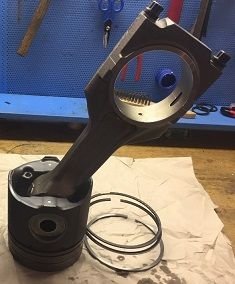Let's have some mechanics – part 3 - for Dummies
Previously on LHSM
Welcome back my dear mechanical apprentices, I'm happy to see you again, as you already know, we have talked about how an egnine create power, the three basic requirements for a good explosion, intake air, and exhaust function in a turbocompressed diesel engine or naturally aspirated engine.
If you missed the first two articles please, consider reading them before proceeding with this one:
- “LHSM Part 1 – For dummies ” – How engines create power
- “LHSM Part 1 – For dummies ”– Fresh air and exhaust lines
What we will discuss today, is the third fundamental element to generate an explosion inside the chamber, last but not least:
The compression
In the first article we took care of the movement of pistons inside a cylinder, and we saw some mechanical pieces a bit ‘in bulk, which togheter generate the correct compression:
- Piston [1]
- Ring Pistons [2]
- Connecting Rod [3]
- Pin Piston [4]
- Cylinder [5]
- Cylinder head [Seriously? Is like 80 Kg!!]
I will not talk this time about crankshaft and therefore how the movement will be extendend to every single piston in the engine, so let’s focus only on the compression.
Since I did not find anything on internet that could help you better understand how the above mentioned parts are made, I decided to photograph the ones I have in stock, a caliber in the center of the photo will help you better understand the dimensions, keeping in mind that the engine in question is a KTA38 M2 Cummins* of 1200 BHP (Brake Horsepower) used on ships. weighs a total of 4.2 tons and is probably much larger than your car.
Unless you drive a bus…


Piston Rings

When everything will be ready, we will go to mount our spare parts inside the engine, and we will see that the piston will have a clearence inside the cylinder. A cylinder head will be placed, which will have to be an airtight "cap" to prevent the aspirated air from exiting the combustion chamber. The distance between the cylinder and the piston must be almost zero, so that the piston rings, like a spring, adhere perfectly to the cylinder, allowing the piston to always remain in the middle of the stroke.
And that's all
Simple. imagine that now, the piston rising into the cylinder begins to compress the air that can not escape anywhere:
above has a cylinder head, and under piston with elastic rings, can not do anything but stay there, and get compressed.
*I think I need to mention or link something on Cummins and the engine used for this article, so here we have the engine brochure.
In truth, all spare parts were purchased years ago, and are owned by me and my company, and all the images were made from my phone, so, if you want to use them, you have my full consent ...
Thanks for reading everything, we are moving in the right direction.
In the next article we will see the cylinder head to understand "why the hell is so complicated".
See you soon and thanks again.
Ciao @ilbirraiooo! Sbirciavo i tuoi post e ho visto che stai scrivendo prevalentemente di meccanica... Se hai la possibilità di usare Discord puoi passare a trovarci nel server di DaVinci (https://discord.gg/QrnsGBt), base operativa di itastem, la "branca" italiana di steemstem.
Così riusciamo anche a farti spiegare qualche piccolo accorgimento per poter ricevere i voti di steemstem.
Ti aspettiamo!
Arrivo appena sono davanti ad un pc, grazie per l'invito!
You got a 6.22% upvote from @inciter courtesy of @ilbirraiooo!